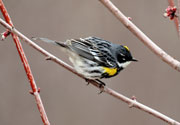20. Hazen Park
Onondaga Street, Oromocto

Head west along the trail that parallels the Oromocto River and enter an enchanted floodplain forest of Silver and Red Maples. Springtime water levels force the river inland to the base of this old railway line. Where land and water collide birds find edge habitat that offers them food, water, and shelter. The filter feeding puddle ducks are found in abundance here. American Black Ducks, Mallards, and Blue-Winged Teal sift their way through tremendous volumes of water in order to strain out a few floating seeds of grasses and wild rice that are the carbohydrates of choice. Wood Ducks, with their specialized bills and dietary preferences, search out the acorns of Red Oaks who dominate the higher knolls and intervale ridges that dot the river shoreline. The Oromocto is a placid river, baptized centuries ago by the Maliseet as ‘Welamooktook’, the good river for easy canoeing. In addition to human travel a seldom acknowledged navigation of epic proportions occurs every spring and summer beneath the surface of the river. Hundreds of thousands of spawning Gaspereau or Alewife, use the Oromocto as a major travel route to access seasonally flooded wetlands that function as hatcheries and nurseries. These anadromous fish will lay millions of eggs here that ensure the return of their kind back to the ocean. The placid waters and slow current that made this river important to the Maliseet are also the conditions that have created the favourite eatery of the fish raptors and spearers. An evening walk along the trail or a canoe paddle on the river just before sunset gets you up close and personal with the large number of Osprey and American Bald Eagles perched among the trees waiting to take the offering that is allotted to them by Mother Nature, the weakened or injured. Below the perched raptors stand the Great Blue Herons, the most patient of nature’s chess players, whose careful stalking moves in the muddy shallows can culminate in a checkmate position for some unsuspecting Gaspereau.
In the shrub layer of alders and willows, play the brightly coloured Yellow Warblers. These neon lit birds, complete with prominent red streaks on the chest of adult males, are relatively tame, photogenic and patient, giving even the most amateur of photographers an image they will be proud to show off. Along your route several trails will branch off the main trail and enter the forest. The first of these avenues will escort you right in among the tree huggers. Hairy and Downy Woodpeckers work their way up and down expiring hardwoods, whose role now in the larger scheme of things is to provide these specialized bug eaters with enough protein to fuel their daily activities. Take the second branch off the main trail and work your way into Ducks Unlimited’s Town Marsh Project. This emergent wetland is the place of residence of Double Crested Cormorants who roost in the flooded trees within the marsh, and the superbly camouflaged sky-gazing American Bittern who can be found standing alongside the walls of cattails or foraging for frogs among stands of wild rice. Tree swallows will delight you almost to the point of annoyance as they parade overhead with their continuous liquid chirping and gurgling, and the harsh alarm chatter that affirms their disapproval of your presence. Under the overhanging shoreline of exposed and tentacle-like tree roots scurry the Spotted Sandpipers, who seem to be in a desperate search for a last bit of supper before darkness invades. The curtain of fading light in the evening sky is the backdrop that obscures the arrival of American Black Ducks, Mallards, American Widgeon, Green-winged Teal, and Wood Ducks. These bands of dusk flyers have their navigation systems set on buckbean and horsetail sloughs, and beaver-flooded alder swales. These tangled and remote night roosts are selected because they provide an abundance of cover waterfowl require during their most vulnerable period of the day. Upon arrival at the roost site guard duties are assigned to sentinels from each species. These birds are responsible for the safety of the flock and fulfill this obligation by scrutinizing anything that might seem out of the ordinary. Survival is the critical outcome of this duty.
On your twilight-lit return the annoyance inflicted by the belligerent cavity nesting Tree Swallows might seem the sweetest thing one could imagine once you run into a few representatives of the bugs these birds do their best to remove from the scenery!